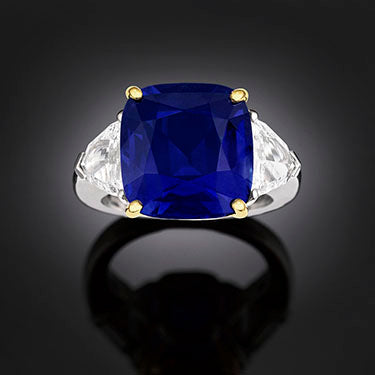
22.11-Carat Asscher-Cut Golconda Diamond Ring
Gemstones have reigned as subjects of legend since antiquity, prized for their outstanding rarity and breathtaking beauty. But how did these illustrious jewels come to be, and why do we value them so much? The answer is an elaborate puzzle that, without every single piece perfectly in place, gemstones would not exist. Keep reading to learn more about the humble beginnings of these beautiful gems and how they transform into the jewelry pieces we love.
The formation of gemstones within the earth's surface is a topic that continues to fascinate scientists. This is not due to a lack of understanding, but more so because of the precision of this multifarious process. It takes millions of years for jewels to form, and only if the right conditions are present. It is the exact combination of space, temperature, pressure, chemical elements and time that makes all gemstones possible. All of these factors must be present, and the specificity and likelihood of these processes occurring at the perfect time is a rarity in and of itself.
Scratching The Surface

3.95-Carat Burma Ruby and Diamond Ring
To understand gemstone formation, one must delve into a bit of geology. The earth comprises the core, the mantle and the crust. The core is essentially a solid, central center surrounded by liquid, both of which consist of an iron-nickel alloy. Outside of the core is the mantle, the outer portion of which is molten rock known as magma. This portion of the earth comprises 80% to 85% of the earth’s volume and plays a vital role in the creation of gemstones. All gems form in the outermost portion of the earth known as the crust. The exceptions to this are diamonds and peridot, which are the only jewels that form in the mantle.
The crust is composed of plates that essentially float atop the viscous mantle. Where the crust and mantle meet is a very volatile area of tremendous pressure and temperature. Heat currents keep the mantle in constant motion, much like river currents, and the resulting movement of the plates resting on top gives rise to various fractures and cavities, including mountains and volcanos. These openings allow magma to seep out and reach the surface becoming lava. It is these cavities that are the birthplace of gemstones.
What’s Cooking?
The ever-flowing magma is constantly exposed to other elements as it travels through the mantle and in and out of spaces that lead to the earth’s surface. They melt into the magma forming fluids that change the chemical composition of the magma, which is the next step in gemstone formation. These ingredients differ from place to place explaining the variety that exists in gemstones, and why certain jewels are found in specific locales around the world. In fact, there are approximately 200 types of known gemstones, each with a specific chemical composition that makes them unique. These chemical components escape from the magma and get deposited as they travel through the cavities in the crust. Within the cavities, the extreme pressure and temperature essentially “cook” the trapped chemical rich fluids. At this point, gemstones begin to form.

Kashmir Sapphire Ring
Tick-Tock
Once the necessities of space, temperature, pressure and ingredients have come together at the right place, in the right amount and at the right moment, all that is needed is time. This may sound simple enough, but as discussed, the earth is constantly changing. Whether it is the less obvious vagaries happening under our feet, or more apparent phenomena such as earthquakes, volcanic activity and even the weather, time becomes less of an abundant commodity. Any severe disturbances during the growth process that cut off the burgeoning jewel deposit from any of the necessities, and the gemstone will cease to form.
If a gemstone is fortunate enough to have gone undisturbed and allowed to fully develop, the question now becomes finding it? The earth’s crust, depending on the location, can vary from approximately 3 to 25 miles deep. Ironically, the very same environmental fluctuations that can work against the gemstone can now work for it. As the earth’s plates shift pushing areas of the crust up, gemstone deposits move up as well, coming ever closer to the surface. Years upon years of erosion by wind, rain and moving water work to remove layers of rock and soil, making gemstone deposits accessible.

6.38-Carat Untreated Colombian Emerald
Diamond and peridot, however, are formed in the mantle, and are believed to reach the surface via explosive volcanic eruptions. The magma must travel at great velocity for these gemstones to survive the long journey to the surface, because if they were exposed to the magma for too long, they would be destroyed. Once on the surface, these two jewels get imbedded into the cooled volcanic rock. Again, erosion comes into play, helping to put these precious beauties within reach. Regardless of the route, it is fascinating to consider that the gemstones mined today began their journey millions of years ago, even before the age of the dinosaurs.
The Spice of Life
Gemstones come in seemingly limitless combinations of composition and color. As discussed, it is largely the specific chemical makeup that determines the variety seen in gems. Diamonds, for example, are made purely of carbon and are colorless. If this carbon was exposed to nitrogen during the growth process, the diamond would possess a yellow coloration. If the element boron were present, it would be blue. Green diamonds are believed to have had their chemical structure rearranged by radiation in the earth, while rearrangement induced by extreme volcanic heat at a specific point in development is believed to give rise to red and pink diamonds.

The Majestic Pink Diamond, a GIA-certified 12.27-carat Natural Fancy Pink Diamond, Type IIa with VVSI clarity
Emeralds are formed of a mineral largely made of a chemical mix of silicon, oxygen, aluminum and beryllium known as beryl. The jewel’s green hue is thanks to the addition of chromium and vanadium. Again, different trace elements change the chemical composition of this mineral to form a diverse beryl family that includes aquamarine and alexandrite.
Sapphires and Rubies are actually the same mineral as well, known as corundum. If traces of titanium and iron are present during growth, the jewel attains the rich blue color, while traces of chromium result in a vibrant crimson. Corundum is another mineral that is found in a variety of colors, but it is only red corundum that known as a ruby. All other colors are commonly referred to as sapphire.
The diversity found in the gemstone world is simply astonishing. Even more impactful is that none of this would be possible without each and every environmental factor coming together under absolutely perfect conditions. Space, pressure, temperature, chemical elements and time come into balance, in a precisely and delicately arranged dance that has been in motion long before our own existence. Precious gifts of nature that have historically been the objects desire, beauty and rarity, these natural wonders continue to amaze, leaving an everlasting impression on our collective conscience.
Browse our collection of gemstone jewelry and admire some of nature’s finest creations.







